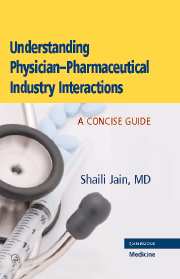Book contents
- Frontmatter
- Contents
- Acknowledgments
- Foreword
- Introduction
- 1 Gifts from the Pharmaceutical Industry to Physicians: Do They Influence your Prescribing?
- 2 Ethical Considerations of Receiving Gifts from the Pharmaceutical Industry
- 3 One on One: An Analysis of the Physician–Pharmaceutical Company Representative (PCR) Detailing Interaction
- 4 Medical Academia and the Pharmaceutical Industry
- 5 Teaching Physicians in Training about Pharmaceutical Industry Promotion
- 6 Continuing Medical Education: How to Separate Continuing Medical Education from Pharmaceutical Industry Promotion
- 7 Professional Policies on Physician–Pharmaceutical Industry Interaction (PPII)
- 8 Preserving Professionalism: Patients' Perceptions of Physicians' Acceptance of Gifts from the Pharmaceutical Industry
- 9 To Sample or Not to Sample? The Use of Pharmaceutical Industry–Supplied Medications in Medical Practice
- 10 Physician–Pharmaceutical Industry Interactions (PPIIs), the Law and the Media
- 11 Direct-to-Consumer Advertising (DTCA)
- 12 Pharmaceutical Industry Interactions with Health Care Professionals: A Global Perspective
- 13 Internet Resources for Teaching about PPII and Independent Sources of Information about Prescription Medicines
- Appendix I
- Appendix II
- Index
- References
5 - Teaching Physicians in Training about Pharmaceutical Industry Promotion
Published online by Cambridge University Press: 03 March 2010
- Frontmatter
- Contents
- Acknowledgments
- Foreword
- Introduction
- 1 Gifts from the Pharmaceutical Industry to Physicians: Do They Influence your Prescribing?
- 2 Ethical Considerations of Receiving Gifts from the Pharmaceutical Industry
- 3 One on One: An Analysis of the Physician–Pharmaceutical Company Representative (PCR) Detailing Interaction
- 4 Medical Academia and the Pharmaceutical Industry
- 5 Teaching Physicians in Training about Pharmaceutical Industry Promotion
- 6 Continuing Medical Education: How to Separate Continuing Medical Education from Pharmaceutical Industry Promotion
- 7 Professional Policies on Physician–Pharmaceutical Industry Interaction (PPII)
- 8 Preserving Professionalism: Patients' Perceptions of Physicians' Acceptance of Gifts from the Pharmaceutical Industry
- 9 To Sample or Not to Sample? The Use of Pharmaceutical Industry–Supplied Medications in Medical Practice
- 10 Physician–Pharmaceutical Industry Interactions (PPIIs), the Law and the Media
- 11 Direct-to-Consumer Advertising (DTCA)
- 12 Pharmaceutical Industry Interactions with Health Care Professionals: A Global Perspective
- 13 Internet Resources for Teaching about PPII and Independent Sources of Information about Prescription Medicines
- Appendix I
- Appendix II
- Index
- References
Summary
Jack briefed his medical team on the management of Mrs. Bratton's hyponatremia. They all congregated outside her room on the corridor of a busy teaching hospital. Jack was enjoying being a chief resident, especially his time as an attending when he could teach. After rounds, Jack sat writing some notes. The exhausted post call team sitting around him broke into conversation … last night's football scores; the latest hospital gossip; what to have for dinner. “Hey, I know,” said the senior resident, Craig. “The MedCorp rep told me to call him if we ever wanted to go out for dinner … he told me he'd take us to Zucci's.” Craig picked up the phone and minutes later had arranged for the whole team to be taken out to one of the most expensive restaurants in the city. “Dr. Jones, are you coming?” asked Craig as they all headed out. Jack smiled uneasily. “No, I don't think so, guys … you go have fun.” As he watched his team file out, Jack sat back and thought about what had just happened. His team had worked hard and done a good job, but he wondered if, as their teacher and supervisor, it was okay for him to sanction their free dinner.
Medical students have extensive exposure to pharmaceutical industry marketing during their early years of training. The need to educate physicians in training about PPII and PI promotion (i.e., to increase their promotional literacy) has been highlighted by researchers.
- Type
- Chapter
- Information
- Understanding Physician-Pharmaceutical Industry InteractionsA Concise Guide, pp. 23 - 29Publisher: Cambridge University PressPrint publication year: 2007



